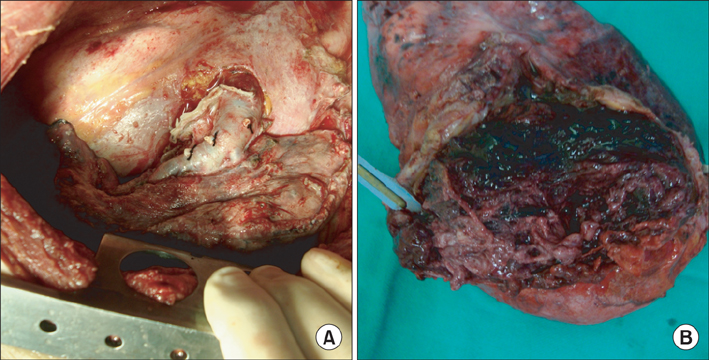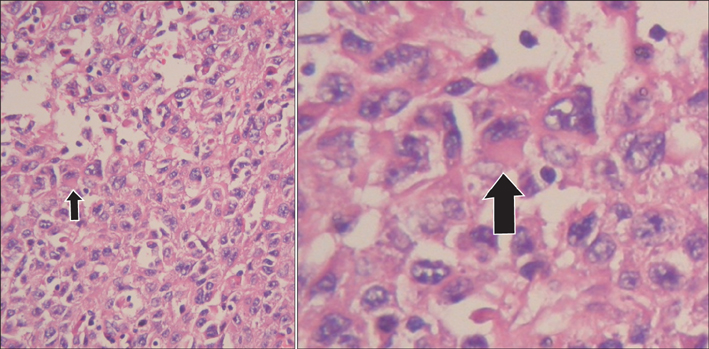Tuberc Respir Dis.
2014 Jul;77(1):38-41.
A Case of Lung Carcinoma with Rhabdoid Phenotype Mimicking an Aspergilloma in Patient with Recurrent Hemoptysis
- Affiliations
-
- 1Division of Tuberculosis and Pulmonology, Department of Internal Medicine, Kwangju Christian Hospital, Gwangju, Korea. coldmilk97@hanmail.net
Abstract
- Malignant rhabdoid tumor was first discovered in the kidney, and rhabdoid tumor of the lung was first reported in 1995. These were included as the variants of large-cell carcinoma, according to the 1999 World Health Organization classification of lung tumors. The rhabdoid tumor of the lung exhibits aggressive biological behavior and has a poor prognosis, and only a few reports of this tumor exist. We report a case of lung carcinoma with a rhabdoid phenotype, initially misdiagnosed as an aspergilloma, in a 48-year-old man who presented with recurrent hemoptysis. The chest computed tomography scans showed a huge consolidative lesion with an air crescent sign in the left upper lung and no contrast-enhancing lesion. An aspergilloma was diagnosed by the radiologist. However, after surgical excision and pathological examination, rhabdoid carcinoma was diagnosed. A surgical resection helps to make it possible to pathologically distinguish a malignancy from an aspergilloma.
Keyword
MeSH Terms
Figure
Reference
-
1. Beckwith JB, Palmer NF. Histopathology and prognosis of Wilms tumors: results from the First National Wilms' Tumor Study. Cancer. 1978; 41:1937–1948.2. Colby TV, Koss MN, Travis WD. Tumors of the lower respiratory tract. Atlas of tumor pathology. Fascicle 13. Washington, DC: AFIP;1995. p. 311.3. Travis WD, Colby TV, Corrin B, Shimosato Y, Brambilla E. Histological typing of the lung and pleural tumours. Berlin: Springer-Verlag;1999. p. 40–42.4. Tamboli P, Toprani TH, Amin MB, Ro JS, Ordonez NG, Ayala AG, et al. Carcinoma of lung with rhabdoid features. Hum Pathol. 2004; 35:8–13.5. Parham DM, Weeks DA, Beckwith JB. The clinicopathologic spectrum of putative extrarenal rhabdoid tumors. An analysis of 42 cases studied with immunohistochemistry or electron microscopy. Am J Surg Pathol. 1994; 18:1010–1029.6. Cavazza A, Colby TV, Tsokos M, Rush W, Travis WD. Lung tumors with a rhabdoid phenotype. Am J Clin Pathol. 1996; 105:182–188.7. Shimazaki H, Aida S, Sato M, Deguchi H, Ozeki Y, Tamai S. Lung carcinoma with rhabdoid cells: a clinicopathological study and survival analysis of 14 cases. Histopathology. 2001; 38:425–434.8. Saini G, Kumar M, Julka PK, Puri T, Sharma M, Rath GK. Rhabdoid variant of lung cancer: clinicopathological details of a case and a review of literature. J Cancer Res Ther. 2009; 5:54–57.9. Travis WD, Brambilla E, Muller-Hermlink HK, Harris CC. World Health Organization classification of tumors: pathology and genetics of tumors of the lung, pleura, thymus and heart. Lyon: IARC Press;2004. p. 45–50.10. Haas JE, Palmer NF, Weinberg AG, Beckwith JB. Ultrastructure of malignant rhabdoid tumor of the kidney. A distinctive renal tumor of children. Hum Pathol. 1981; 12:646–657.11. Park Y, Kim TS, Yi CA, Cho EY, Kim H, Choi YS. Pulmonary cavitary mass containing a mural nodule: differential diagnosis between intracavitary aspergilloma and cavitating lung cancer on contrast-enhanced computed tomography. Clin Radiol. 2007; 62:227–232.12. Wu CY, Hu HY, Pu CY, Huang N, Shen HC, Li CP, et al. Pulmonary tuberculosis increases the risk of lung cancer: a population-based cohort study. Cancer. 2011; 117:618–624.13. Hiroshima K, Shibuya K, Shimamura F, Toyozaki T, Haga Y, Ohwada H, et al. Pulmonary large cell carcinoma with rhabdoid phenotype. Ultrastruct Pathol. 2003; 27:55–59.
- Full Text Links
- Actions
-
Cited
- CITED
-
- Close
- Share
- Similar articles
-
- A Case of Large Cell Lung Carcinoma with Rhabdoid Phenotype Presenting as Cutaneous Metastasis
- Sequential Surgical Treatment of Hemoptysis Caused by: A case report
- A case of endobronchial aspergilloma with massive hemoptysis
- A Case of Pulmonary Aspergilloma in Bronchogenic Cyst Associated with An Actinomycosis
- A case of endobronchial aspergilloma in patient with collapse of right middle lobe




